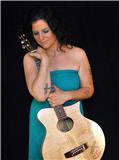
Have you met Sahffi? She's beautiful, has a voice that will make you a true believer, plays a guitar - which she got me to build, and has a couple of really good CD's. Be sure to check out her web site at http://www.sahffi.com.
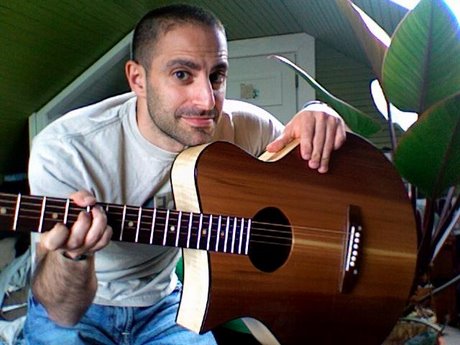
Justin appears to be a troubadour of the Rich Mullins variety. He's presently on the West Coast, but I think he's from everywhere. I like my Ambassador model guitar, but mine is of the smaller variety. I build 2 different sizes, and one is just too dog gone big for a boy like me. But it's just right for a guy like Justin.
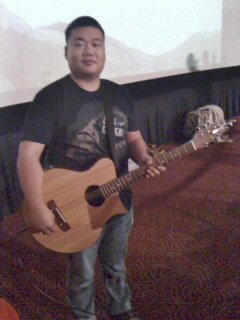
West Coast Sam plays one of my black walnut Ambassador guitars.
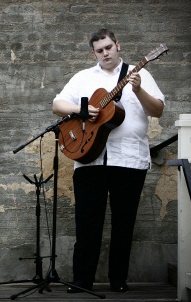
Donít you wish you had a wife like Jennifer Crosbie Watson? As a wedding gift for Michael, she got me to build him the guitar of his choosing. And he played that guitar at their reception. This is a grand concert with ďFĒ type sound holes and a floating bridge. He went with a good looking piece of redwood for the top, and black walnut for the sides, back, and neck.
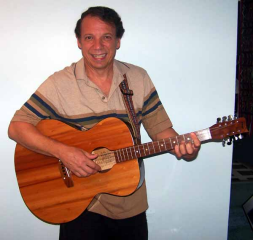
Every time I think Iíve built everything that can be thought of, somebody comes along to prove me wrong. Rich sings Dean Martin songs, and he sings like Dean Martin. He got me to build him a tenor. A tenor is a rare enough instrument as it is, but this is an 8 string tenor tuned in octaves. And the body is a jumbo. So thatís a whole lot of sound coming out of that guitar. You can catch up with Rich at http://www.amoredeanmartin.com/Rich%20as%20Rich.html, or rseven@optonline.net.
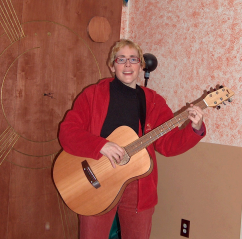
Thereís a gentleman who holds the record for owning more of my dulcimers than anybody else Iíve built for. Graham and his wife, Rosalind, are both musicians. I finally got to build for her also. Thereís a book out that details the top forty favorite woods for luthiers. When it comes to production instruments, thereíre only a few choices. Generally, production companies offer woods that are readily available. There are lots of other woods that build a good looking, good sounding instrument, but they would be a bit more difficult to keep in stock on a regular basis. Since I have a sawmill and harvest a lot of my own wood, I can have a lot of choices. Rosalindís guitar has pecan for the sides, back, and neck with a western red cedar top. And it is a Sojourner model.
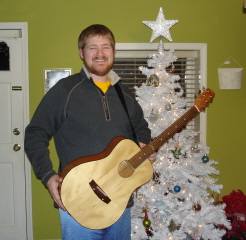
Andrew Osenga helped develop the Sojourner guitar. Over the years, a lot of folks who like Andrew Osenga and/or like a small body guitar have gotten me to build one. This is Blake for Alabama. I wish I could promise the same service to everybody that I was ablt ot give him. My wife, son, and I went to visit my folks on the East coast for Thanksgiving 2006. I had just completed Blakeís Sojourner, and we were going right by where he and his family live. Generally, when I ship a guitar, it stays on my mind, and requires a lot of prayer. And I donít rest well until I know it has arrived without incident. So, I was able to hand deliver his guitar, and actually got to meet Blake. Now thatís a rarity for me. Seldom do I ever get to meet the folks I build for. And only every once in awhile do I get a picture to even know what the owner looks like. So, thereís one more friend of Andrew and follower of Jesus out there with a Sojourner.

As of April 2006, here is my newest offering. The attempt was to arrive at something that's being promised among some guitar builders. Folks are always catching up with me about the possibility of building a solid body electric guitar with these pickups that are alleged to make your solid body sound like an acoustic. I don't want to give the impression that the present supposed acoustic pickups are worthless, but they just don't quite deliver on their promise. Some have even told me that feeding their guitar through an acoustic amp still doesn't arrive at the desired end. This guitar came out of a collaboration between my son, Stewart, and me. Let me tell you all about it and I'll make every effort at being honest about the benefits and limitations of this guitar. This is a thin bodied Ambassador. There are some thin bodied acoustic electric guitars that have jazz pickups in them. Those thin bodied guitars have thick tops and often the body is chambered. The pickups I've installed in this guitar are standard pickups used in a solid body electric. They have a single coil in front of the bridge and a humbucker in the sound hole. There are sound hole pickups made for acoustic guitars, but this is not one. It's probably not visible from the picture, but the single coil pickup at the bridge is not touching the top. It is mounted on two aluminum rails that are attached to the bridge. This top is the same thickness and braced the same as all of my other acoustic guitars. Since this pickup doesn't touch the top, it doesn't produce a stiff spot. Also, on the inside of the top, I have hard glued two piezo pickups near where the outer tips of the bridge are. These are the standard pickups I use in an acoustic guitar. In the upper bout, we have tone, volume, and two different switches. One is an on/on/on switch that controls the two coil pickups. And the other is an on/on pickup that switches power from the coils to the piezos. There is no preamp in this guitar. Now, I didn't make these pickups, but here's a bit of truth about them. They don't need a preamp. They do need an equalizer. There are an assortment of equalizers out there to be had - some for a lot of money and some for a little. The seven band equalizer Danelectro sells called Fish & Chips is a good buy at about $30. This guitar actually does let you switch from playing some good hard rock through the coils to playing some honest to God acoustic with the piezos. Now here's some limitations, and we've tried it out and have found the boundaries. A solid body electric guitar will have generally as few as 21 frets and up to 24 frets, and all of them will be accessible. That is not the case on this one. My guitars don't have a heel. The neck bolts on to the body and this Ambassador bolts on at the 15th fret. Most acoustic guitars have a neck that crosses the body at the 14th fret, and with the heel that is typically on an acoustic neck, a person usually gets about 12 frets of usefulness. Mine allows for 15 frets of playing. This body is thin, but it is not as thin as a solid body. A solid body is typically 1 1/2" in depth. This guitar is about 3" in depth. This one you're seeing is the prototype and it's not for sale. We worked out all of the details and ended up filling in a few holes from some experiments that were not satisfactory. On most of my instruments, I'm very negotiable. But on this guitar, I know what it took to make it functional. So there are probably a few options to be had, but a lot of what's on this guitar has to be just this way for it to work. My starting price for one like this is going to be $700.
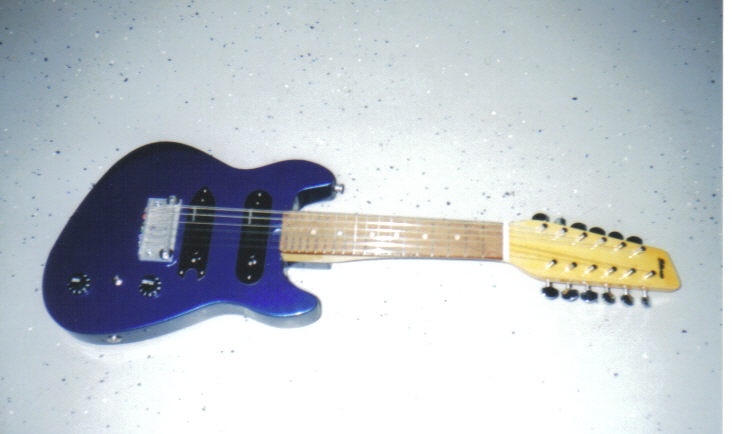
This is a solid body electric 12-string mandoguitar. A lot of different options are possible, but here's the particular run-down on this one. The neck and body are both ash and the body is painted metal flake blue. I equipped this mandoguitar with EMG stacked humbuckers. It has tone, volume, and a three-way selector switch. The after market industry doesn't appear to provide a bridge suitable for the string spacing needed on these pickups, so I made my own bridge. My starting price will be $550, plus $25 for shipping. This mandoguitar will come in a very nice thick padded gig bag.
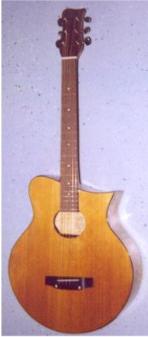
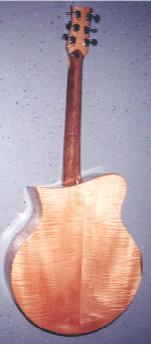
This is the Elloree Ambassador guitar. It is of the same body shape as my Elloree Ambassador mandolin. It comes with a 25 5/8" string length.
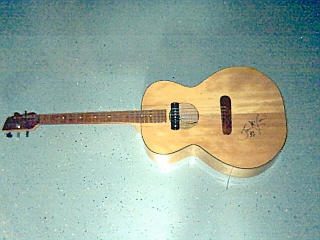
This is my personal guitar. Since I only play a little, I didn't even bother with a cutaway. I do florentine and venetian cutaways, they're optional. It's a 25 5/8 string length, with a piranah top. I always use straight grained wood and never instrument plywood. Piranah looks and sounds every bit as good as spruce, at a fraction of the cost. The body shape is grand concert, I also build dreadnaughts and small bodied acoustics.
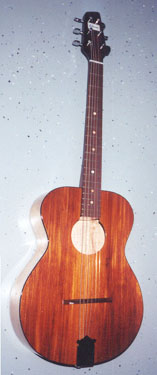
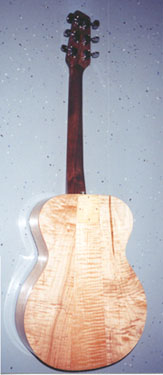
The industry doesn't offer a true childs guitar. There are several guitars out there that have a small body, but that's as far as it goes. All of the supposed children's guitars I've seen had a standard size neck. The frets are standard, and generally, the strings are the same size as those of a full size guitar. This is the second childs guitar I've built for a family that is intent on starting their children off on something that can actually be played by a child. Truth is, you would have to be a child to be able to play this guitar. The neck is much narrower and thinner than standard. The frets are the same ones I use for a mandolin. The strings are extra light. It has a 22" string length. The overall length of this instrument is 34". It has a lower bout of 11 3/4". The upper bout is 9 1/2", with a 15 1/4" length for the body, and about 3 1/4" in depth. The fretboard crosses the body at the 14th fret, and the neck is bolted on, just as on all of my other instruments. I build this guitar from the same quality materials I use in my other instruments. It's made of all straight grain wood and no instrument plywood.
My dreadnaughts can be had with our without a cutaway. I am presently charging $50 extra for black walnut sides, back, and neck. Although dreadnaughts are often thought of as bulky to hold, mine are a bit more comfortable. The sides on my instruments are all parallel sides. The body does not get deeper as it heads towards the lower bout. Because of the overall construction and type of woods used, there is no sacrifice in tone.
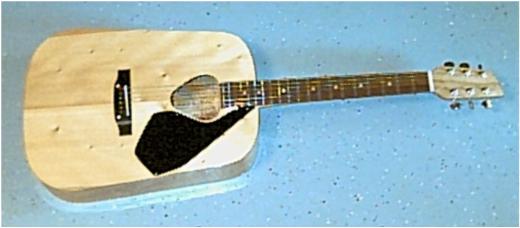
I would like to introduce the Herald guitar. Among us luthiers, we've always known how to make a really good sounding guitar. The problem is often tradition. Tradition dictates a lot of what we do, even if it's not in the best interest of sound or durability. Everything that we do on an instrument is a trade-off. We get something and we give something up. It's difficult to sit and play an acoustic guitar unless that guitar has a waist. You can't reach all of the frets on the acoustic guitar unless you have a cutaway. All of these things that we add to make an instrument more convenient also has an adverse effect on the tone. The best sounding guitar would be shaped like a sphere, but would be impossible to play. I've spent considerable time designing this guitar with two goals in mind - tone and playability. Without a doubt, this body shape produces the best sound of any guitar I build. In the upper bout, it's about 12". The lower bout is about 14 1/2". The overall length of the body is 20", which is about the standard length of a dreadnaught body. I have parallel sides on my instruments. In other words, the sides don't get deeper as they head toward the lower bout. From lower bout to upper bout, the sides are 4" in depth. This overall design allows for easy playability while sitting or standing, and the tone is incredible. Now I realize I am not all things to all people. I'm at least two or three steps off of the beaten path here, so if a traditional look has to be your thing, then probably this guitar would not be for you. If your main objectives are tone and playability, then you may consider this one.
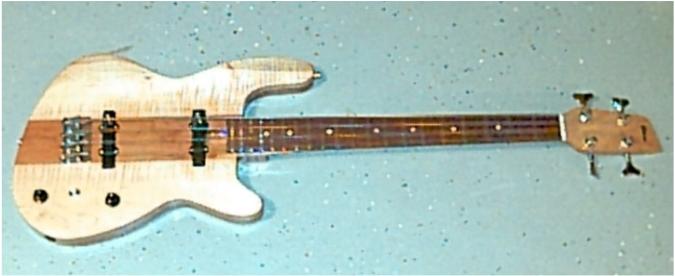
The Seraph body style is available as a bass. The only alteration to the body is that it has a longer top horn. As always, there are different choices to be had on electronics and woods.

This is my Angel model, and you are viewing a company of angels. I try hard to pay attention to women and children. I probably have an equal number of both who are wanting a guitar, and I am generally told that women and children are frustrated by the fact that there's nothing offered just for them. The body is too big. The neck is too long, too deep, too wide of a neck. Any number of things that prevents them from being able to comfortably play a guitar. This is my most serious attempt at offering something that will be playable to ladies and small people in general. This guitar body is a little bit bigger than what is known as a parlor guitar, but it is definitely smaller than a dreadnaught. All of these guitars shown here have the same body size, but that's where the similarity ends. There are a variety of choices in woods, and each one has a different string length and neck width. At no additional charge, I intend to fit this guitar to the specific needs of the person who is wanting it. The body size is 15" in the lower bout, 8 1/2" in the waist, and 10 5/8" in the upper bout. As a rule, I make the body depth at 4" with parallel sides. However, that is subject to change according to a person's specific needs.
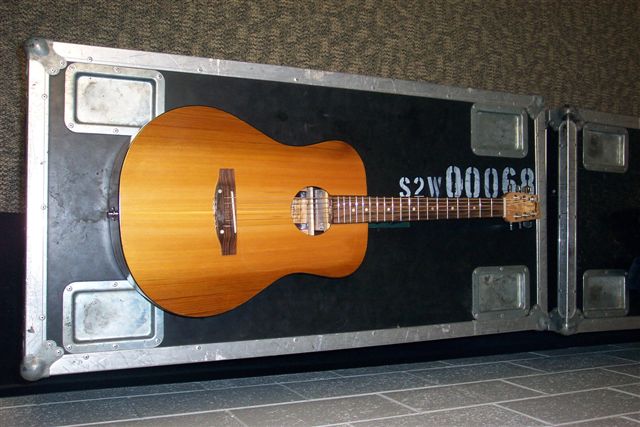
I'm offering this model as a standard thing. It was actually designed by and built for Andrew Osenga - formerly of The Normals and presently of Caedmon's Call. This model is the Sojourner. He wanted something with sort of the shape of a dreadnaught, but not quite as big. A standard dreadnaught has a 16" lower bout and the body is about 20" long. This one has a 15" lower bout and the body is 19" in length. As with all of my guitars, different string lengths and depths of body are possible. Also, there are the wood choices to be had.
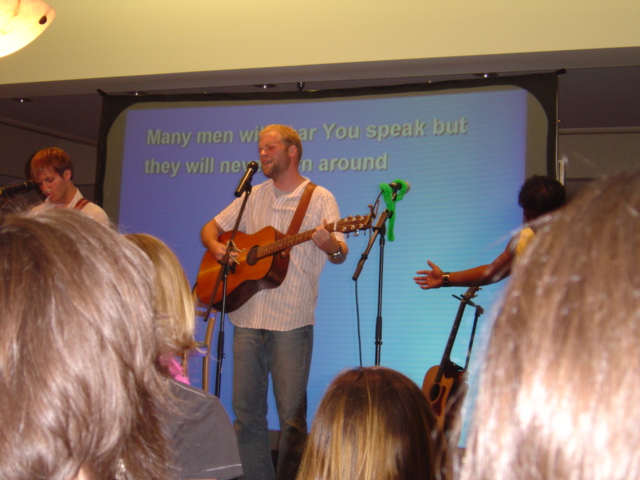
Rick,
What can I say? This guitar is great. I am completely satisfied and I have to say the guitar sounds incredible. I was somewhat unsure what the guitar would sound like before I got it. I had never actually heard one and I was just basing my purchase off of reviews. Well, the reviews were right. I would easily put this guitar up against my Taylor guitars any-day. The sound is incredible and the guitar itself is beautiful. The guitar just offers a sound that can't be found in a store bought guitar. It was a pleasure to do business with you and I am looking forward to doing so in the future. I have always wanted a mandolin so maybe before too long we can start talking about having you build me a mandolin also. If anyone is ever curious about your guitars and they would like to talk to someone who owns one, I would gladly answer any questions they have and tell them about how pleased I am with my Elloree Guitar. Just have them email me. Well, I hope all is well with you, your family, and Lindsay.
In Him
Dustin Howell